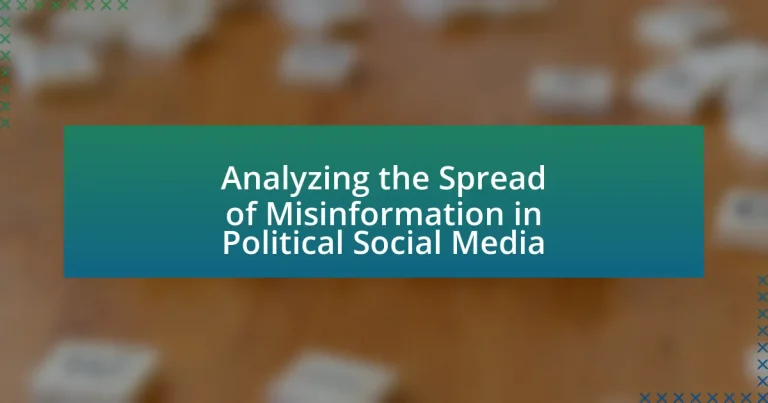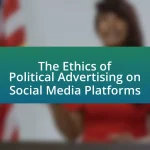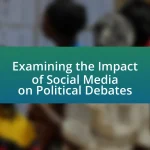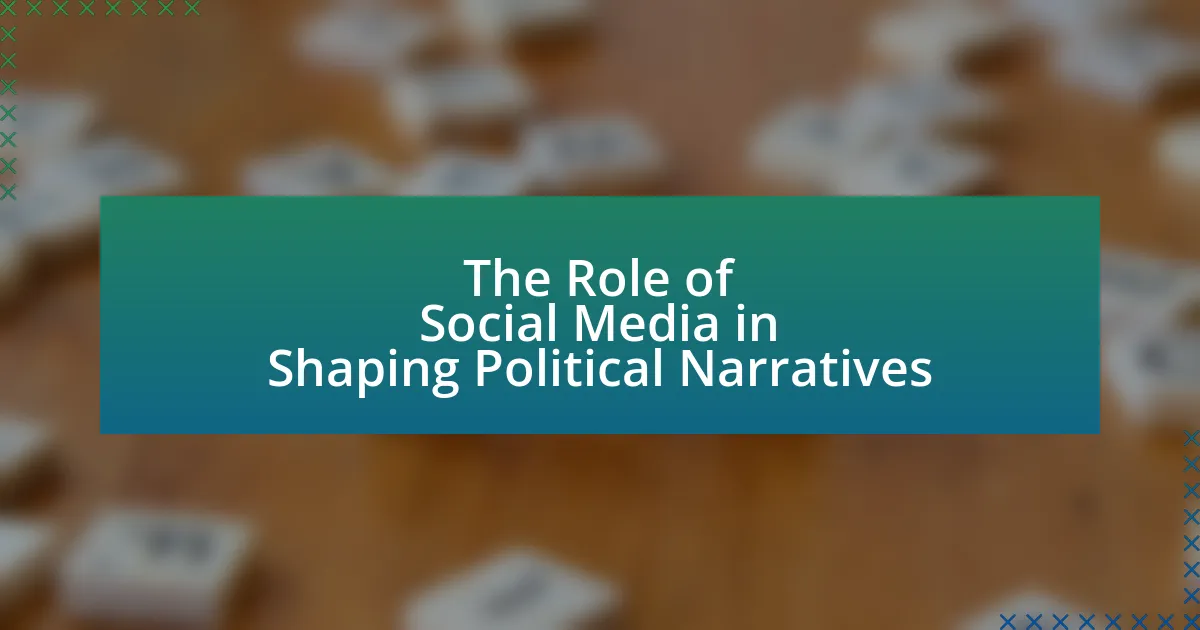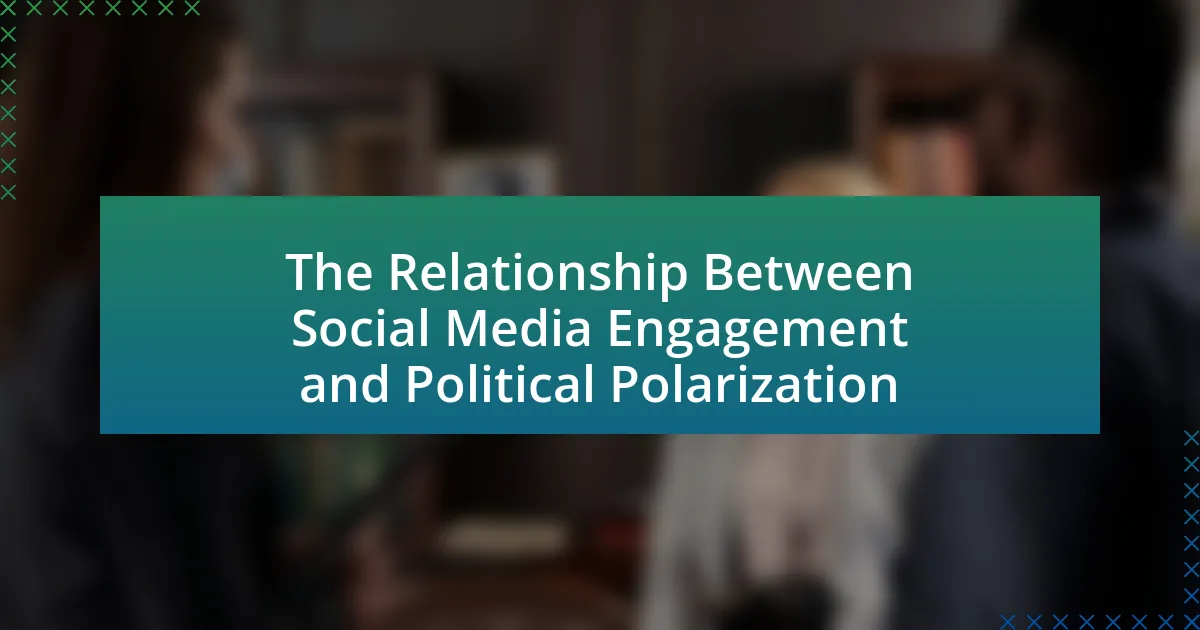The article analyzes the spread of misinformation in political social media, highlighting its rapid dissemination and significant influence on public opinion and political behavior. It discusses how algorithms prioritize engagement over accuracy, leading to the proliferation of false narratives, misleading statistics, and fabricated quotes. The article emphasizes the role of social media platforms, user behaviors, and external factors in exacerbating misinformation, particularly during critical events like elections. Additionally, it outlines strategies for combating misinformation, including fact-checking initiatives, media literacy education, and the implementation of effective policies by social media companies.

What is the Spread of Misinformation in Political Social Media?
The spread of misinformation in political social media refers to the rapid dissemination of false or misleading information that influences public opinion and political behavior. Research indicates that misinformation spreads more quickly and widely than factual information, with a study published in Science in 2018 revealing that false news stories are 70% more likely to be retweeted than true stories. This phenomenon is exacerbated by algorithms that prioritize engagement over accuracy, leading to echo chambers where users are exposed primarily to information that aligns with their existing beliefs. Additionally, the 2020 U.S. presidential election highlighted the role of social media platforms in amplifying misinformation, with significant impacts on voter perceptions and behavior.
How does misinformation manifest in political social media platforms?
Misinformation manifests in political social media platforms through the rapid dissemination of false or misleading information, often amplified by algorithms that prioritize engagement over accuracy. This phenomenon is evident in the spread of fake news articles, manipulated images, and misleading statistics that can influence public opinion and voter behavior. For instance, a study by the Pew Research Center found that 64% of Americans believe that fabricated news stories cause confusion about the basic facts of current events. Additionally, social media platforms often lack effective moderation, allowing misinformation to proliferate unchecked, which can lead to significant impacts on political discourse and election outcomes.
What types of misinformation are commonly found in political contexts?
Common types of misinformation found in political contexts include false narratives, misleading statistics, and fabricated quotes. False narratives often involve the distortion of facts to create a misleading story, such as the misrepresentation of a politician’s stance on an issue. Misleading statistics can be used to support a political argument while omitting crucial context, such as presenting data without acknowledging its source or methodology. Fabricated quotes attribute statements to public figures that they never made, which can significantly influence public perception and opinion. These forms of misinformation are prevalent in political discourse, particularly on social media platforms, where rapid sharing can amplify their impact.
How do social media algorithms contribute to the spread of misinformation?
Social media algorithms contribute to the spread of misinformation by prioritizing content that generates high engagement, often amplifying sensational or misleading information. These algorithms analyze user interactions, such as likes, shares, and comments, to determine which posts are shown more prominently in users’ feeds. Research indicates that misinformation is more likely to be shared than factual information, with a study published in “Science” showing that false news stories are 70% more likely to be retweeted than true stories. This engagement-driven model incentivizes the creation and dissemination of misleading content, as users are more likely to interact with provocative or emotionally charged posts, leading to a cycle that perpetuates misinformation.
Why is analyzing misinformation in political social media important?
Analyzing misinformation in political social media is crucial because it directly impacts public opinion and democratic processes. Misinformation can distort facts, leading to misinformed voters and skewed electoral outcomes. For instance, a study by the Pew Research Center found that 64% of Americans believe fabricated news stories cause confusion about the basic facts of current events. This highlights the significant role misinformation plays in shaping perceptions and behaviors in the political landscape. By understanding and addressing misinformation, stakeholders can promote informed decision-making and uphold the integrity of democratic systems.
What impact does misinformation have on public opinion and political behavior?
Misinformation significantly distorts public opinion and influences political behavior by shaping perceptions and beliefs based on false or misleading information. Research indicates that exposure to misinformation can lead to increased polarization, as individuals may adopt extreme views that align with the misleading narratives they encounter. For instance, a study published in the journal “Science” by Vosoughi, Roy, and Aral in 2018 found that false news spreads more rapidly on social media than true news, leading to widespread misconceptions among the public. This distortion can result in altered voting behavior, decreased trust in institutions, and increased susceptibility to manipulation by political actors.
How does misinformation affect democratic processes and elections?
Misinformation significantly undermines democratic processes and elections by distorting public perception and influencing voter behavior. It creates confusion among the electorate, leading to misinformed decisions that can alter election outcomes. For instance, a study by the Pew Research Center found that 64% of Americans believe fabricated news stories cause a great deal of confusion about the basic facts of current events. This confusion can result in decreased voter turnout, as individuals may feel disillusioned or uncertain about the integrity of the electoral process. Furthermore, misinformation can exacerbate polarization, as individuals gravitate towards false narratives that reinforce their existing beliefs, ultimately eroding trust in democratic institutions.
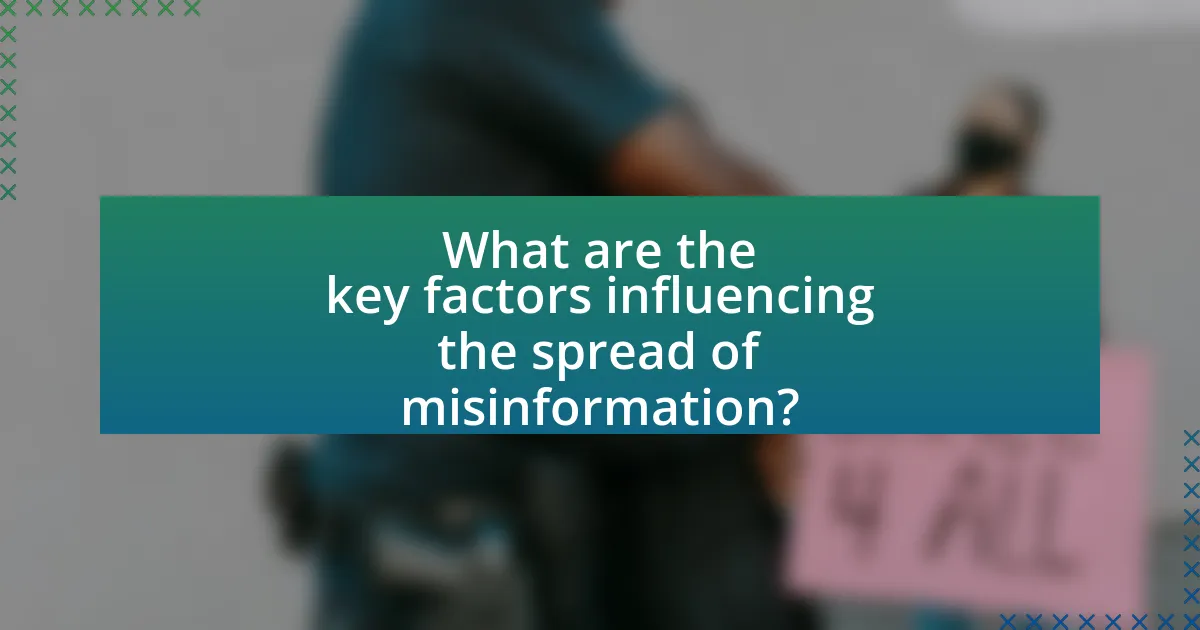
What are the key factors influencing the spread of misinformation?
The key factors influencing the spread of misinformation include social media algorithms, cognitive biases, and the role of influential figures. Social media algorithms prioritize content that generates engagement, often amplifying sensational or misleading information. Cognitive biases, such as confirmation bias, lead individuals to accept information that aligns with their preexisting beliefs while dismissing contradictory evidence. Additionally, influential figures, including politicians and celebrities, can significantly impact the dissemination of misinformation through their platforms, as their endorsements or shares can rapidly increase the visibility of false claims. Research indicates that misinformation spreads more quickly than factual information on social media, highlighting the urgency of addressing these factors to mitigate its impact.
How do user behaviors contribute to the dissemination of misinformation?
User behaviors significantly contribute to the dissemination of misinformation by amplifying false narratives through sharing, liking, and commenting on misleading content. When users engage with sensational or emotionally charged posts, algorithms prioritize this content, increasing its visibility and reach. A study by Vosoughi, Roy, and Aral (2018) published in Science found that false news spreads more rapidly on social media than true news, primarily due to user interactions that favor sensationalism. This behavior creates a feedback loop where misinformation gains traction, leading to widespread acceptance and belief among users.
What role do echo chambers and filter bubbles play in misinformation spread?
Echo chambers and filter bubbles significantly contribute to the spread of misinformation by isolating individuals within homogeneous information environments. These environments reinforce existing beliefs and limit exposure to diverse viewpoints, which can lead to the acceptance of false information as truth. Research indicates that social media algorithms often prioritize content that aligns with users’ preferences, creating filter bubbles that further entrench misinformation. A study by Bakshy et al. (2015) in “Proceedings of the National Academy of Sciences” found that users are less likely to encounter opposing viewpoints, which exacerbates the spread of misinformation within these echo chambers.
How does emotional engagement influence the sharing of misinformation?
Emotional engagement significantly increases the likelihood of sharing misinformation. Research indicates that content eliciting strong emotional responses, such as fear or anger, is more likely to be shared on social media platforms. A study by Vosoughi, Roy, and Aral (2018) published in Science found that false news stories spread more rapidly than true stories, primarily due to their emotional appeal. This emotional engagement compels individuals to share content without verifying its accuracy, leading to a higher prevalence of misinformation in political discourse.
What external factors exacerbate the spread of misinformation?
External factors that exacerbate the spread of misinformation include social media algorithms, political polarization, and the rapid dissemination of information. Social media algorithms prioritize engagement, often amplifying sensational or misleading content over factual reporting, which can lead to widespread misinformation. Political polarization creates echo chambers where individuals are more likely to accept false information that aligns with their beliefs, further entrenching misinformation. Additionally, the rapid dissemination of information through digital platforms allows misinformation to spread quickly before it can be fact-checked or corrected, as evidenced by studies showing that false news spreads six times faster than true news on Twitter.
How do political affiliations and biases affect the perception of misinformation?
Political affiliations and biases significantly shape how individuals perceive misinformation, often leading them to accept false information that aligns with their beliefs while dismissing contradictory evidence. Research indicates that individuals are more likely to believe misinformation that supports their political views, a phenomenon known as confirmation bias. For instance, a study published in the journal “Political Psychology” by Lewandowsky, Ecker, and Cook (2017) demonstrates that people with strong partisan identities are less likely to recognize misinformation when it aligns with their political stance, thereby reinforcing their existing beliefs. This selective acceptance of information contributes to the polarization of public opinion and complicates efforts to combat misinformation in political contexts.
What is the role of influential figures and organizations in spreading misinformation?
Influential figures and organizations play a significant role in spreading misinformation by leveraging their platforms and credibility to disseminate false or misleading information. These entities often have large followings, which amplifies the reach of their messages, making it easier for misinformation to spread rapidly across social media networks. For example, during the COVID-19 pandemic, various public figures and organizations shared unverified claims about treatments and vaccines, contributing to widespread confusion and distrust. Research from the Pew Research Center indicates that misinformation is more likely to be shared when it originates from trusted sources, highlighting the impact of influential figures in shaping public perception and behavior.
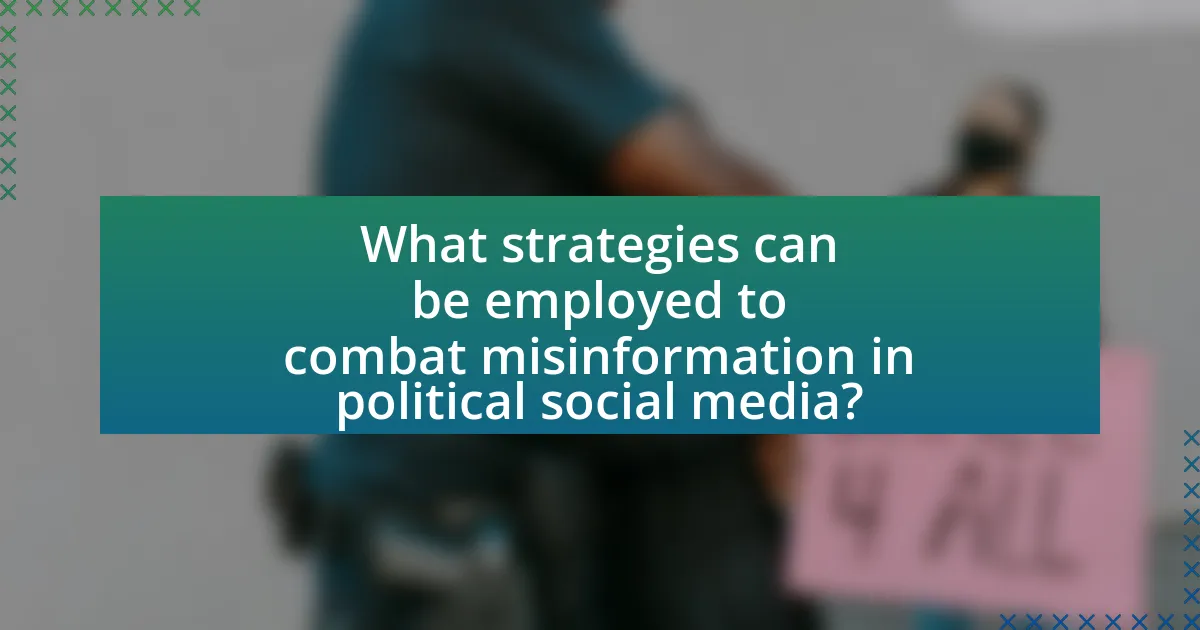
What strategies can be employed to combat misinformation in political social media?
To combat misinformation in political social media, strategies such as fact-checking, media literacy education, and algorithmic transparency can be employed. Fact-checking organizations, like PolitiFact and Snopes, actively verify claims made on social media, providing users with accurate information and reducing the spread of false narratives. Media literacy education equips individuals with critical thinking skills to assess the credibility of sources and discern factual information from misinformation. Additionally, promoting algorithmic transparency allows users to understand how content is prioritized and shared, enabling them to recognize potential biases and misinformation in their feeds. These strategies collectively contribute to a more informed public and a reduction in the impact of misinformation in political discourse.
How can fact-checking initiatives help reduce misinformation?
Fact-checking initiatives can significantly reduce misinformation by verifying claims and providing accurate information to the public. These initiatives employ trained professionals who assess the validity of statements made in political discourse, often using reliable sources and evidence. For instance, a study by the Pew Research Center found that fact-checking can influence public perception, as individuals exposed to fact-checked information are less likely to believe false claims. Additionally, platforms that incorporate fact-checking tools can flag misleading content, thereby discouraging its spread. This proactive approach not only informs users but also fosters a culture of accountability among content creators, ultimately leading to a more informed electorate.
What are the most effective fact-checking practices in social media?
The most effective fact-checking practices in social media include the use of automated tools, collaboration with independent fact-checkers, and promoting media literacy among users. Automated tools, such as algorithms and AI, can quickly identify and flag potentially false information based on established databases and patterns. Collaboration with independent fact-checkers, like organizations certified by the International Fact-Checking Network, ensures that claims are verified by credible sources, enhancing the reliability of the information presented. Promoting media literacy empowers users to critically evaluate the information they encounter, reducing the spread of misinformation. These practices are supported by studies indicating that platforms employing such strategies see a significant decrease in the circulation of false narratives.
How can users identify and report misinformation effectively?
Users can identify and report misinformation effectively by verifying the credibility of sources and utilizing fact-checking tools. To verify sources, users should check the author’s credentials, the publication’s reputation, and cross-reference information with reliable outlets. Fact-checking tools like Snopes, FactCheck.org, and PolitiFact provide evidence-based assessments of claims. Research indicates that misinformation spreads rapidly on social media, with a study by Vosoughi, Roy, and Aral (2018) in “Science” showing that false news stories are 70% more likely to be retweeted than true stories. By employing these strategies, users can contribute to reducing the spread of misinformation.
What role do social media platforms play in mitigating misinformation?
Social media platforms play a crucial role in mitigating misinformation by implementing fact-checking mechanisms, content moderation policies, and user education initiatives. These platforms, such as Facebook and Twitter, employ algorithms to identify and flag false information, often collaborating with third-party fact-checkers to verify claims before they spread widely. For instance, Facebook reported that its fact-checking efforts reduced the distribution of false news stories by 80% in 2020. Additionally, platforms provide users with tools to report misinformation and promote credible sources, thereby enhancing public awareness and critical thinking. This multifaceted approach helps to limit the reach of misleading content and fosters a more informed user base.
What policies can social media companies implement to address misinformation?
Social media companies can implement policies such as fact-checking partnerships, content labeling, and algorithm adjustments to address misinformation. Fact-checking partnerships with independent organizations can help verify the accuracy of information shared on their platforms, reducing the spread of false claims. Content labeling can inform users when posts contain disputed information, prompting critical evaluation before sharing. Additionally, algorithm adjustments can prioritize credible sources and reduce the visibility of misleading content, as evidenced by Facebook’s implementation of these strategies, which led to a reported 50% decrease in the spread of misinformation during the 2020 U.S. elections.
How can technology be leveraged to detect and limit misinformation spread?
Technology can be leveraged to detect and limit misinformation spread through advanced algorithms and machine learning techniques. These technologies analyze vast amounts of data across social media platforms to identify patterns indicative of misinformation, such as unusual spikes in sharing or engagement metrics. For instance, platforms like Facebook and Twitter utilize AI-driven fact-checking systems that cross-reference claims with verified sources, flagging or removing content that is deemed false. Research from MIT has shown that false news spreads six times faster than true news on social media, highlighting the need for effective technological interventions. By employing natural language processing, sentiment analysis, and user behavior tracking, technology can significantly reduce the reach and impact of misinformation, ensuring that users are presented with accurate information.
What are best practices for individuals to avoid spreading misinformation?
Individuals can avoid spreading misinformation by verifying information before sharing it. This involves checking the credibility of the source, cross-referencing facts with reliable outlets, and being aware of the context in which the information is presented. Research indicates that misinformation spreads more rapidly on social media platforms, with a study by Vosoughi, Roy, and Aral (2018) published in Science showing that false news stories are 70% more likely to be retweeted than true stories. Therefore, individuals should critically evaluate the information they encounter and refrain from sharing unverified content to mitigate the spread of misinformation.
How can users critically evaluate information before sharing it?
Users can critically evaluate information before sharing it by verifying the credibility of the source, checking for supporting evidence, and assessing the context of the information. Credible sources typically include established news organizations, academic institutions, or experts in the relevant field. Users should cross-reference the information with multiple reliable sources to confirm its accuracy. Additionally, examining the context involves understanding the intent behind the information, such as identifying potential biases or agendas. Research indicates that misinformation spreads more rapidly on social media platforms, emphasizing the importance of critical evaluation to mitigate its impact (Vosoughi, Roy, & Aral, 2018, Science).
What resources are available for users to verify political information online?
Users can verify political information online through various resources, including fact-checking websites, government databases, and reputable news organizations. Fact-checking websites like Snopes, FactCheck.org, and PolitiFact provide analyses of claims made in political discourse, often citing original sources and evidence. Government databases, such as the Federal Election Commission and state election offices, offer official information on political candidates and election processes. Reputable news organizations, including The Associated Press and Reuters, maintain high journalistic standards and provide accurate reporting on political events. These resources collectively help users discern the validity of political information and combat misinformation.
